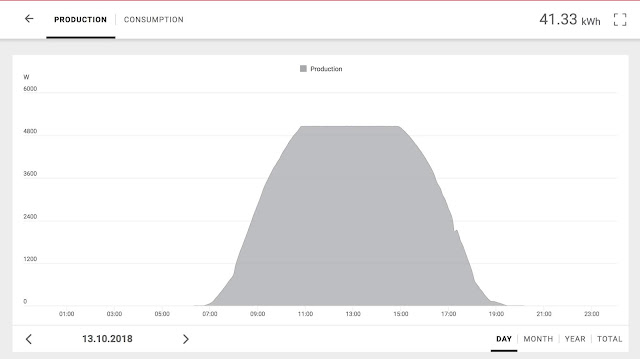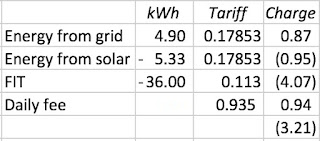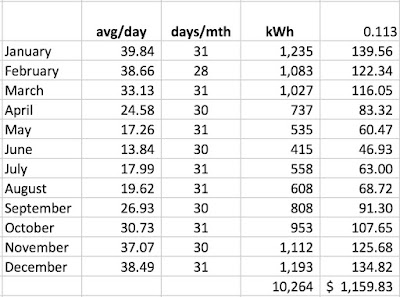Are Solar Panels worth it?
Back in 2011 we put on a 2kw solar system onto our house in Melbourne. Back then the panels were only 180w and we had 11 of them. The feed in tariff (FIT) was set at 60c until the end of 2024. The system cost $3750 after the government rebate and I guestimated that we broke even after 3 years, taking into account what we would have paid in electricity had we not had solar and the FIT we received. The data available now will make this calculation much more accurate. Our electricity or gas were with the same supplier and we never paid a bill for either in those three years.
Rolling onto 2018, we moved into a larger house with no solar. We replaced all the downlights with 11w LEDs and the question came up - do we put in solar again. My husband emphatically wanted to but I wasn't sure if it was worth it now that the FIT had been reduced to 11.3c. I read up about solar on the web and asked for three quotes. One came, one didn't even call and the other said we didn't use enough power to warrant it. Our wholesaler is United Energy and they have a portal that allows you to see what energy you are using per hour/day/month and you can download reports. The last company got me to send one of these reports which was how he knew what we used - though to be fair it was May and we had only been here a few weeks. We were averaging 9kWh's per day. The cold hadn't settled in and we weren't using the central heating much. I was torn, what to do? if in doubt, do nothing.
I did some more research including reading a book called the Good Solar Guide that I got from my library which explains kW's and kWh's, panels, inverters, sizes etc. I decided that we would go ahead. The first quote we got was for a 9kw system, this was just too expensive and I seeing as we weren't going to be using much solar directly, I couldn't see the point.
There are lots of scenarios you need to take into account when choosing the size of your system. Are you going to be adding batteries later? They are too expensive at the moment even with the new government rebate. Batteries only have a 10 year lifespan, so if you aren't ahead within that 10 years, they aren't worth it. Are you going to be charging an electric car? not yet but you never know. Our energy usage has increased so much over the past few years - think computers, laptops, tablets, mobiles (x how many people the household), large screen TV's, PVR's, set top boxes, home automation, internet, mood lighting - all of these things consume power. We are also increasing our usage of air conditioning. When we moved into our last house in 2002 we didn't have any air conditioners. Then five years on, we couldn't sleep and had to get one. We built an extension and put one in the new room but didn't use it initially. A few years later we found we needed to. Now we have a house with ducted air-conditioning throughout the house - it's not going to be cheap to run. Climate change is making Melbourne more humid and I think we will keep increasing our cooling going forward. These were some of these reasons why I decided that we would go ahead with installing solar, it might take 7 years to pay off, but then again it might not.
Some energy providers only give a FIT if the system is 5kw or smaller, and I thought this was a good size anyway. We ordered a 6.6kw system with a 5kw inverter - this means that no more than 5kw can go into the system at a time. It is recommended that you have a more solar panels than what the inverter needs - which means that you are getting more power during either side of the peak period. We were going away in a few weeks so decided to book it for when we got back. What a stroke of luck that was. The Victorian Government announced a new rebate on top of the one they already give and we were eligible!
A friend in Queensland had a 5kW solar system on Queensland's old 44c FIT scheme but he moved house and took his solar system with him, he now has a lower FIT of 8c and for the first time in six years had a power bill when he usually got an annual cheque for $2,400. He couldn't understand why I would buy a solar system now. It will be interesting to see what our figures are in a few months and whether it was worth it.
Changing your schedule
When you have solar, you need to think about when you use your most power hungry appliances. Changing dinner to lunch is going to extremes but with modern appliances you can set your washing machine and dishwasher timers to make these appliances run during the day. This is in complete contrast to people on the 60c FIT, when you would put these appliances on at midnight if you have off peak tariffs, but if you are on a flat rate, then run them anytime after the sun goes down.
In September before day light saving the solar system was putting in a few thousand watts around 10am so this is when I would then put the washing machine on. There is an app for Fronius inverters that lets you see at what rate you are generating energy. Because we weren't connected to the grid for the FIT, I could see that I didn't use any energy from the grid at this time, so the washing machine was drawing all its energy from the solar panels. During day light saving and because the days are getting longer, the same wattage generation occurs between 8:30-9am depending on the day.
How can you tell what energy you are generating?
Inverter manufacturers have apps or websites that you can log into to see your production and if you pay for a premium service, you can also track your consumption.
How can you tell what energy you are consuming?
If you don't want to subscribe to a premium service you can get this information from your energy wholesaler. On the Mornington Peninsula, this is United Energy. It will show you what you have consumed from the grid and what you have fed back to the grid.
About my system
We have a 6.6kw system, with 21x 310W panels with a 5kW inverter. We have had our system for just under a month and our best day of generation was 41.76kWh, our worst when it rained was 10.22kWh; our average from mid August to mid October was 28kWh. If we wish to add more panels in the future, we would have to add a separate system as technology would have changed too much for the old panels to talk to the new inverter that would be required. We are in Victoria on the Mornington Peninsula, so our panels are facing North. The Victorian Government's FIT is currently 11.3c. Some retailers have a higher rate but their billing system usually has pay on time discounts which make it very difficult to understand if you are getting a better deal.
How are we doing so far?
On Saturday we generated 41.33kWh of solar, we used 4.9kWh from the grid and used 5.33kWh from the solar system as I did some washing. Our FIT for that day was 36kWh (taking the 36 from the 41.33 gave me what we used from our system before it went to the grid). This was a very sunny day, so not all days are going to be as good as this.
So, are solar systems worth it now that the FIT is so low. I don't know yet but I will let you know in a few months time.
I will need more data to estimate how long it will take to pay off the system.
Rolling onto 2018, we moved into a larger house with no solar. We replaced all the downlights with 11w LEDs and the question came up - do we put in solar again. My husband emphatically wanted to but I wasn't sure if it was worth it now that the FIT had been reduced to 11.3c. I read up about solar on the web and asked for three quotes. One came, one didn't even call and the other said we didn't use enough power to warrant it. Our wholesaler is United Energy and they have a portal that allows you to see what energy you are using per hour/day/month and you can download reports. The last company got me to send one of these reports which was how he knew what we used - though to be fair it was May and we had only been here a few weeks. We were averaging 9kWh's per day. The cold hadn't settled in and we weren't using the central heating much. I was torn, what to do? if in doubt, do nothing.
I did some more research including reading a book called the Good Solar Guide that I got from my library which explains kW's and kWh's, panels, inverters, sizes etc. I decided that we would go ahead. The first quote we got was for a 9kw system, this was just too expensive and I seeing as we weren't going to be using much solar directly, I couldn't see the point.
There are lots of scenarios you need to take into account when choosing the size of your system. Are you going to be adding batteries later? They are too expensive at the moment even with the new government rebate. Batteries only have a 10 year lifespan, so if you aren't ahead within that 10 years, they aren't worth it. Are you going to be charging an electric car? not yet but you never know. Our energy usage has increased so much over the past few years - think computers, laptops, tablets, mobiles (x how many people the household), large screen TV's, PVR's, set top boxes, home automation, internet, mood lighting - all of these things consume power. We are also increasing our usage of air conditioning. When we moved into our last house in 2002 we didn't have any air conditioners. Then five years on, we couldn't sleep and had to get one. We built an extension and put one in the new room but didn't use it initially. A few years later we found we needed to. Now we have a house with ducted air-conditioning throughout the house - it's not going to be cheap to run. Climate change is making Melbourne more humid and I think we will keep increasing our cooling going forward. These were some of these reasons why I decided that we would go ahead with installing solar, it might take 7 years to pay off, but then again it might not.
Some energy providers only give a FIT if the system is 5kw or smaller, and I thought this was a good size anyway. We ordered a 6.6kw system with a 5kw inverter - this means that no more than 5kw can go into the system at a time. It is recommended that you have a more solar panels than what the inverter needs - which means that you are getting more power during either side of the peak period. We were going away in a few weeks so decided to book it for when we got back. What a stroke of luck that was. The Victorian Government announced a new rebate on top of the one they already give and we were eligible!
A friend in Queensland had a 5kW solar system on Queensland's old 44c FIT scheme but he moved house and took his solar system with him, he now has a lower FIT of 8c and for the first time in six years had a power bill when he usually got an annual cheque for $2,400. He couldn't understand why I would buy a solar system now. It will be interesting to see what our figures are in a few months and whether it was worth it.
 |
| Showing the capping at 5000W (5kW) |
Changing your schedule
When you have solar, you need to think about when you use your most power hungry appliances. Changing dinner to lunch is going to extremes but with modern appliances you can set your washing machine and dishwasher timers to make these appliances run during the day. This is in complete contrast to people on the 60c FIT, when you would put these appliances on at midnight if you have off peak tariffs, but if you are on a flat rate, then run them anytime after the sun goes down.
In September before day light saving the solar system was putting in a few thousand watts around 10am so this is when I would then put the washing machine on. There is an app for Fronius inverters that lets you see at what rate you are generating energy. Because we weren't connected to the grid for the FIT, I could see that I didn't use any energy from the grid at this time, so the washing machine was drawing all its energy from the solar panels. During day light saving and because the days are getting longer, the same wattage generation occurs between 8:30-9am depending on the day.
 |
| Washing was done at 9am, no power from the grid was used |
How can you tell what energy you are generating?
Inverter manufacturers have apps or websites that you can log into to see your production and if you pay for a premium service, you can also track your consumption.
How can you tell what energy you are consuming?
If you don't want to subscribe to a premium service you can get this information from your energy wholesaler. On the Mornington Peninsula, this is United Energy. It will show you what you have consumed from the grid and what you have fed back to the grid.
About my system
We have a 6.6kw system, with 21x 310W panels with a 5kW inverter. We have had our system for just under a month and our best day of generation was 41.76kWh, our worst when it rained was 10.22kWh; our average from mid August to mid October was 28kWh. If we wish to add more panels in the future, we would have to add a separate system as technology would have changed too much for the old panels to talk to the new inverter that would be required. We are in Victoria on the Mornington Peninsula, so our panels are facing North. The Victorian Government's FIT is currently 11.3c. Some retailers have a higher rate but their billing system usually has pay on time discounts which make it very difficult to understand if you are getting a better deal.
How are we doing so far?
On Saturday we generated 41.33kWh of solar, we used 4.9kWh from the grid and used 5.33kWh from the solar system as I did some washing. Our FIT for that day was 36kWh (taking the 36 from the 41.33 gave me what we used from our system before it went to the grid). This was a very sunny day, so not all days are going to be as good as this.
 |
| Tariffs includes GST, except for FIT which I don't think has it. On this day we are in credit by $3.21. |
 |
| Solar production for September. Our system was installed on the 18th September |
 |
| October solar production so far, the 16th has been raining all day |
I will need more data to estimate how long it will take to pay off the system.



Comments
Post a Comment